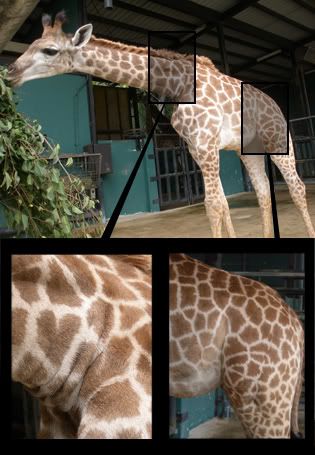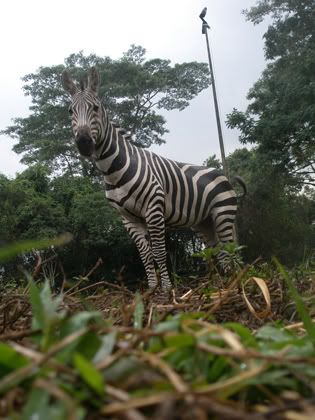iotaish
hello hello. decided to do up my post more... well, quicker. so yea. photos coming up. new section and lucky enough, babies =)


both the babies look entirely different. so i don't think anyone could have got this mix up. The birdie (top) is a Masked Lapwing's chick =) will take a nice photo of the mum, or dad and then i'll introduce them properly.
And... the other babeh. blackish and quite naughty. this ish eh Small toothed Civet's... hmm.. kitten, i guess. a very feisty girl. but too cute. and everyone's completely 'messing' with her everyday. grow up healthy. grow up well. strokie =)
*eh hem. Courtesy of Kami sama's helping hand. thanks*
__________________________________________________________
And then its babeh giraffe again >_<
Kayin
after ive been spending more time in leopard trail, have been spending really alot of time wondering and admiring her beauty till i notice 'heart-shaped' patches on her body. behold, our very own South African Giraffe and her patches :

Did ewu spot teh patchas?
__________________________________________________________
And, yep. A formal introduction finally.
Grant's Zebra


Grant's Zebra
Equus quagga boehmi
Kingdom: Animalia
Class: Mammalia
Order: Perissodactyla
Family: Equidae
Gestation : approximately 12 months; one offspring
(Foals nurse for at least 6 months)
Sexual maturity : About 3 years for females; longer for males
Life span : Averages up to 20 years
- Grant's zebras are the most abundant and widespread of any zebra species or sub-species.
- Found in eastern Kenya and east of the Rift Valley into southernmost Ethiopia
- Grant's zebra herds are composed of one stallion with several mares (usually 7-8) and their juvenile offspring.
- Grant's zebra are very cooperative: a migrating group will adjust their speed to accommodate the slowest member of the herd.
- Zebra mothers will keep a newborn foal separate from the herd for a period of time long enough for the calf to imprint its mothers stripes (which are unique to her), smell, and call.
- Within several minutes of its birth, a newborn zebra begins to walk, and within just a few hours is capable of running with the rest of the herd.
- If forced to face a predator, a zebra will defend itself with powerful kicks. Just one strong, well-placed kick from a zebra is sufficient to kill a predator as large as a hyena.
- The purpose of a zebra's stripes has long been debated. One theory maintains that a zebra herds' stripes serve to disorient predators that rely on their ability to single out one individual. Another theory is based on the uniqueness of each zebra's set of stripes (no two are the same, like a fingerprint), asserting that herd members use their coat patterns to identify one another. This is thought to be of special importance to young foals, which rely on their mother's rump print for recognition when following behind her during travel.
_______________________________________________________
The sheepish sheep. Throw it away. Okay?


both the babies look entirely different. so i don't think anyone could have got this mix up. The birdie (top) is a Masked Lapwing's chick =) will take a nice photo of the mum, or dad and then i'll introduce them properly.
And... the other babeh. blackish and quite naughty. this ish eh Small toothed Civet's... hmm.. kitten, i guess. a very feisty girl. but too cute. and everyone's completely 'messing' with her everyday. grow up healthy. grow up well. strokie =)
*eh hem. Courtesy of Kami sama's helping hand. thanks*
__________________________________________________________
And then its babeh giraffe again >_<
Kayin
after ive been spending more time in leopard trail, have been spending really alot of time wondering and admiring her beauty till i notice 'heart-shaped' patches on her body. behold, our very own South African Giraffe and her patches :

Did ewu spot teh patchas?
__________________________________________________________
And, yep. A formal introduction finally.
Grant's Zebra


Grant's Zebra
Equus quagga boehmi
Kingdom: Animalia
Class: Mammalia
Order: Perissodactyla
Family: Equidae
Gestation : approximately 12 months; one offspring
(Foals nurse for at least 6 months)
Sexual maturity : About 3 years for females; longer for males
Life span : Averages up to 20 years
- Grant's zebras are the most abundant and widespread of any zebra species or sub-species.
- Found in eastern Kenya and east of the Rift Valley into southernmost Ethiopia
- Grant's zebra herds are composed of one stallion with several mares (usually 7-8) and their juvenile offspring.
- Grant's zebra are very cooperative: a migrating group will adjust their speed to accommodate the slowest member of the herd.
- Zebra mothers will keep a newborn foal separate from the herd for a period of time long enough for the calf to imprint its mothers stripes (which are unique to her), smell, and call.
- Within several minutes of its birth, a newborn zebra begins to walk, and within just a few hours is capable of running with the rest of the herd.
- If forced to face a predator, a zebra will defend itself with powerful kicks. Just one strong, well-placed kick from a zebra is sufficient to kill a predator as large as a hyena.
- The purpose of a zebra's stripes has long been debated. One theory maintains that a zebra herds' stripes serve to disorient predators that rely on their ability to single out one individual. Another theory is based on the uniqueness of each zebra's set of stripes (no two are the same, like a fingerprint), asserting that herd members use their coat patterns to identify one another. This is thought to be of special importance to young foals, which rely on their mother's rump print for recognition when following behind her during travel.
_______________________________________________________
The sheepish sheep. Throw it away. Okay?
0 Comments:
Post a Comment
<< Home